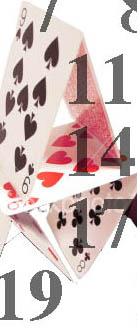
Conclusion: “I Don’t Think I Have What It Takes to Play The Game, But I Enjoy It: The Bricolage, The Music, The Movement”
It is entirely possible to look at Oliver’s game as nonsense, to cite his refusal or inability to play “by the rules” of an established game (Yu-gi-oh) or his inefficacy in explaining “the rules” of the game he invented. There are certainly moments when I’m playing the game with him that it feels more like a story he is telling me (and controlling) than a game we play together or against each other. The evidence for this view of CW as story rather than game comes from Oliver’s movements and sounds. I have witnessed him rocking and singing to himself before (Um-Pha-Pha-Pha, Um-Pha-Pha-Pha…) in his solitary play; it is something he does, in the absence of a playmate, to create a play rhythm. Rocking is also, I’ve noticed in the games he observes his brother playing, a way a player prepares to push his body into action. Playing games, even highly intellectual games like Yu-gi-oh (for 11-year olds at least) a physical activity. It involves taking the focus, occupying the stage during one’s turn, and moving dramatically to make an impression: leaning forward, standing up, yelling (of course, yelling—being loud and taking focus signals to others that you are playing and they must wait).
Rather than see the performative and improvisational aspects of CW as Oliver’s childish variation on the rule-bound, sober Yu-gi-oh, I see them as evidence that Oliver has done active, critical and deep learning as he explores the possibilities of himself as a gamer.
One: Situating Embodied Learning
-
Identity and Learning: “Follow What I Am Doing: Do The Rules That I’m Doing: It’s Very CoM-pli-cated”
- Producelike Behavior: "Why Do The Make Queen Better Than Jack?"
- Conclusion: "The Bricolage, The Music, The Movement"
Three: Implications for the Literacy Autobiography Assignment
